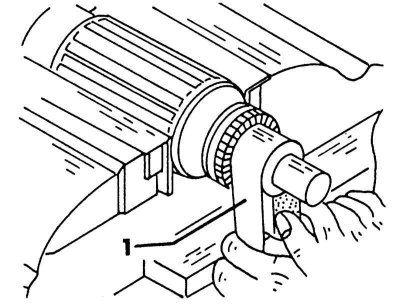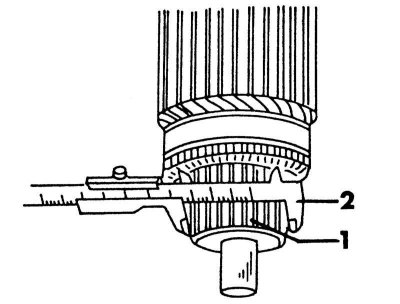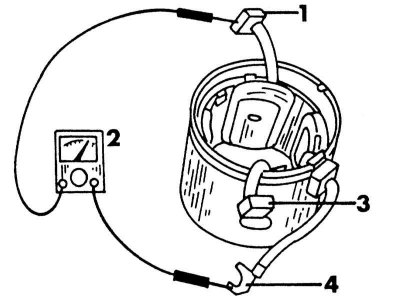Brushes
The brushes must be 5 mm long (with reduction gear) or 3.5 mm (with direct drive). You can use a caliper to measure the brushes.
1. Check that the brushes move easily in the guides. If necessary, wipe the sides of the brushes with a rag soaked in gasoline or file. If required, replace the brushes.
2. Check the tension of the brush springs with a dynamometer, which is installed at right angles to the spring. The result must match the value in Specifications at the beginning of the chapter.
Collector
A good collector should have a smooth surface free of pits and burnt spots.
1. Wipe the collector with a cloth dampened with gasoline while turning the starter. If required, it can be processed with sandpaper (with grain 500 - 600), as shown in the illustration below. To process a badly worn manifold, it can be machined.

Clean the collector with a strip of sandpaper (1). Clamp the anchor in various positions in a vise to clean around the entire circumference.
2. First measure the collector diameter with a caliper. If measured (see illustration below) the diameter is already approaching the minimum allowable value of 28.8 mm, the manifold should be replaced. The anchor for turning is clamped on a lathe, and when rotated at high speeds, a layer of metal is removed. Remove only the right amount of material.

Manifold diameter measurement (1) using a caliper (2).
3. Finally, saw through the slots between the collector segments to a depth of 0.5 - 0.8 mm. The hacksaw blade must be inserted into the slots horizontally in order to cut along all lengths, i.e. do not warp the blade. Then polish the collector with fine sandpaper to make it shine. The most common faults in the collector are due to a short circuit in the armature (burnt manifold coils), otherwise it should work for a long time.
Pole coils
1. It is best to check the pole coils with an ohmmeter, which is connected between the positive terminal of the pole coil and the starter housing, as shown in the illustration below. The illustration shows an ohmmeter with an internal current source. An ohmmeter of a different design must first be connected to the battery. This test checks whether the pole coils are shorted to ground. If the ohmmeter shows any value, the starter housing with pole coils must be replaced.

Checking the insulation between the starter housing (1) and the positive terminal of the pole coil (3). Use an ohmmeter to test (2).
2. In the next test, an ohmmeter is connected between the two brush contacts, as shown in the illustration below. This test checks to see if current flows between the brushes. If there is no indication, the starter housing should be replaced.

Checking the passage of current between the positive terminal of the pole coil and the positive brush
1 - positive brush; 2 - ohmmeter; 3 - positive brush; 4 - positive terminal
Anchor
To check the armature winding, a special device, the so-called buzzer, is required. If this device is not available, you can check the old anchor by temporarily replacing it with a new one. Never try to straighten a bent anchor or process it, i.e. grind or deburr.
Bearings
Badly damaged bearings with lateral play must be replaced. To do this, it is best to measure the outer diameter of the armature shaft and the inner diameter of the bearing bore. If the difference between the two dimensions exceeds 0.2 mm, press out the old bushing, soak the new bushing in clean engine oil for 30 minutes and press it into the bearing shield. Then turn the sleeve until the shaft has a clearance of 0.03 - 0.10 mm.
Starter drive
Check that the starter gear teeth are in good condition. The pinion should move easily on the toothed connection of the armature shaft. The free play should be only in one direction, in the other direction the gear should be blocked. If required, replace the entire drive. In this case, also check the starter ring gear for damage.
Traction relay
The traction relay cannot be repaired. To check the coils of the traction relay, connect a 2-volt battery to the terminals "S" And "M" on the relay. The relay pusher should move. Repeat the same test, but this time connect the battery to the terminal "M" and hull. The pusher should move and when connecting the wire to the terminal "M" be held. Figure 7.m shows where the terminals are located on the relay.